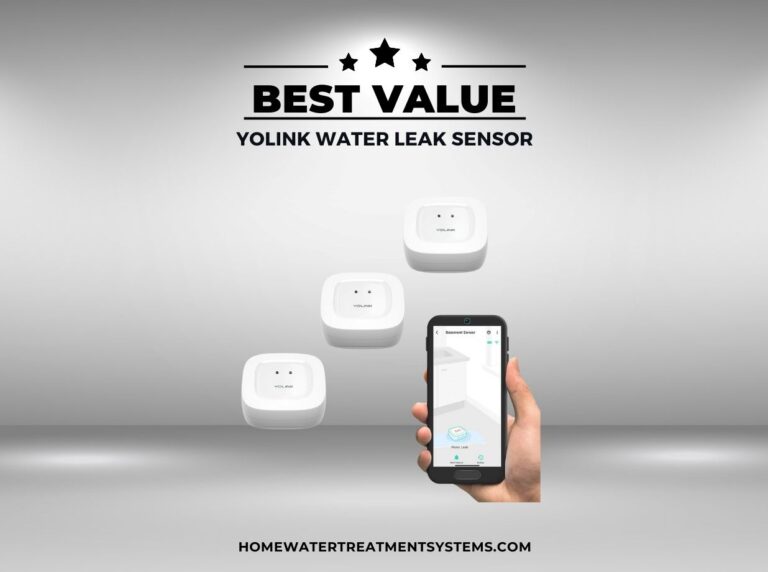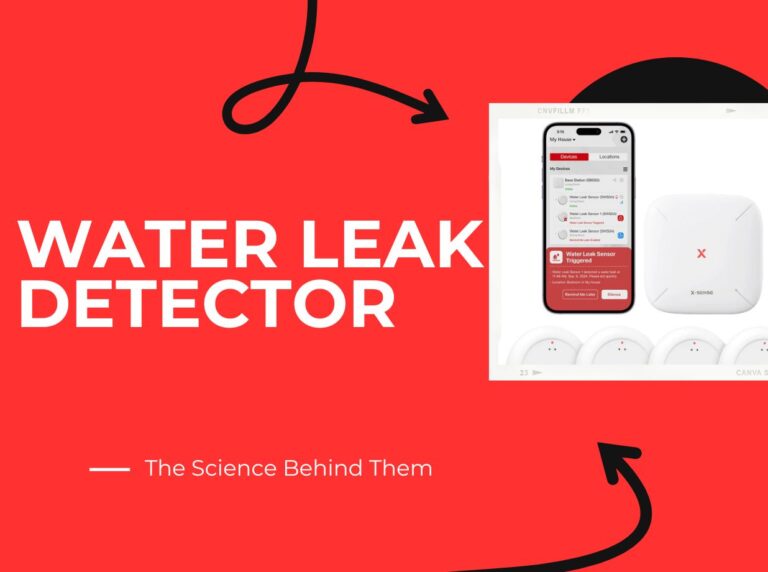Top 10 Water Sensors in 2025: Expert Reviews & Buyer’s Guide
Whether you’re concerned about aging pipes, want to monitor specific appliances, or simply need peace of mind while away from home, today’s smart water sensors offer features like smartphone notifications, integration with home automation systems, and even automatic water shutoff capabilities. Let’s explore the best options to keep your home dry and protected.
Water Sensor Comparison: Top 10 Water Sensors in 2025
| Model | Price | Detection Method | Connectivity | Alert Types | Battery Life | Warranty |
| YoLink Water Leak Sensor 4 | $18.99 | Contact sensors (top and bottom) | LoRa (requires hub) | App, Email, 105dB Alarm | 2 years | 1 year |
| Kidde Water Leak + Freeze Detector | $28.99 | Contact sensors (bottom) | Wi-Fi | App, Email, SMS, 96dB Alarm | 1.5 years | 1 year |
| Proteus Aquo Smart Water Sensor | $99.00 | Contact sensors + cable | Wi-Fi | App, Email, SMS, Voice Call, 83dB Alarm | N/A (AC powered) | 2 years |
| Govee Water Leak Detector 2 | $29.99 | Contact sensors (top and bottom) | LoRa (requires hub) | App, Email, 100dB Alarm | 1.5 years | 1 year |
| Moen Smart Leak Detector | $49.99 | Contact sensors + cable | Wi-Fi | App, Email, 85dB Alarm | 1 year | 1 year |
| Aqara Water Leak Sensor | $19.99 | Contact sensors (bottom) | Zigbee (requires hub) | App, 80dB Alarm | 2 years | 1 year |
| Risinglink Smart Water Level Monitor | $94.99 | Float sensor | Wi-Fi | App, Email, SMS | 1 year | 1 year |
| Shonmau Water Level Detector | $19.99 | Float sensor | None (standalone) | 120dB Alarm | 1 year | 90 days |
| EPTTECH Smart Liquid Level Indicator | $56.00 | Float sensor | Wi-Fi | App, Email | N/A (AC powered) | 1 year |
| Tuehakny 2-in-1 Water Detector | $24.99 | Dual probes | Wi-Fi | App, 100dB Alarm | 1 year | 1 year |
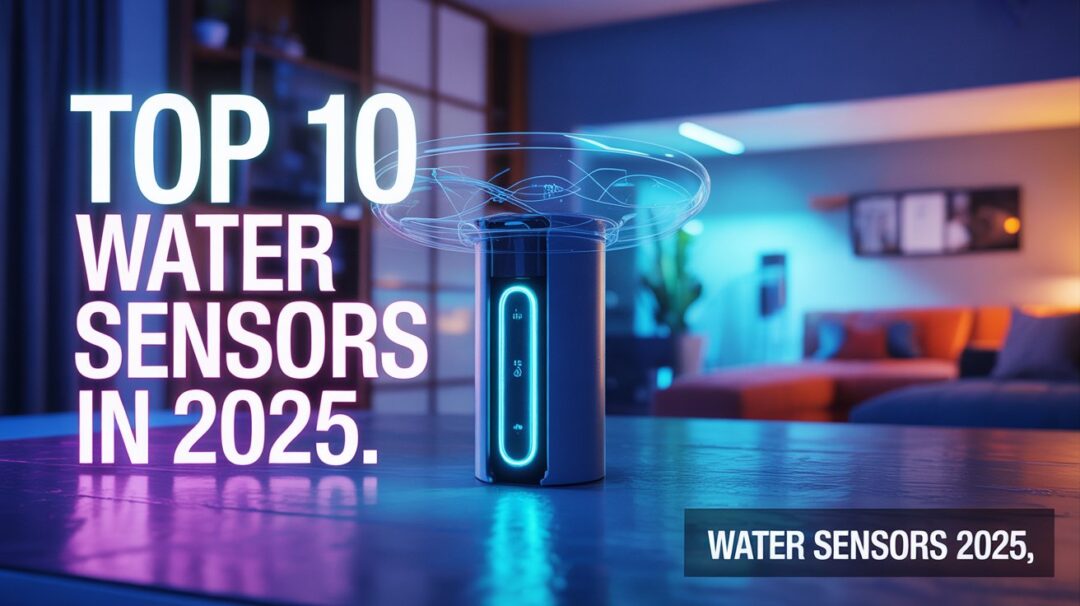 The top water sensors of 2025 come in various designs to suit different monitoring needs
The top water sensors of 2025 come in various designs to suit different monitoring needs
🏆 Editor’s Choice: YoLink Water Leak Sensor 4
After extensive testing, the YoLink Water Leak Sensor 4 stands out as our top recommendation for most homeowners. It offers the perfect balance of affordability, reliability, and smart features. With both top and bottom sensors, quick response time, and excellent smart home integration, it provides comprehensive protection at a price point that allows for multiple sensors throughout your home.
1. YoLink Water Leak Sensor 4 – Best Overall Water Sensor
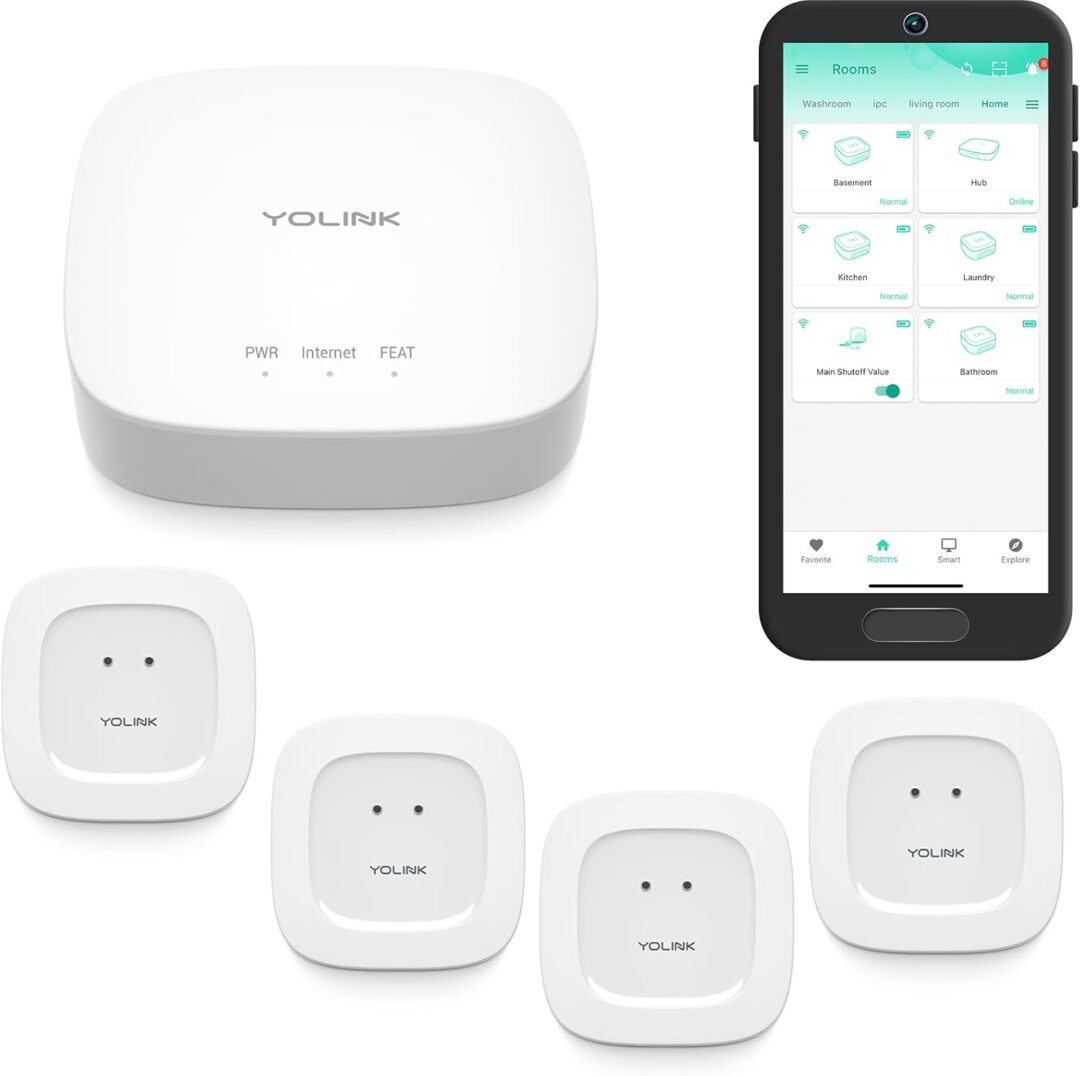
The YoLink Water Leak Sensor 4 earns our top spot by delivering exceptional performance at an affordable price point. This sensor features both top and bottom-mounted probes to detect both pooling water and drips from above, providing comprehensive coverage that many competitors lack.
Key Features
- Dual detection with top cup design to catch drips and bottom probes for pooling water
- Extremely loud 105dB built-in alarm (audible from 30+ feet away)
- LoRa wireless technology with exceptional range (up to 1/4 mile from hub)
- Temperature monitoring to detect potential pipe freezing conditions
- IP66 waterproof rating to withstand heavy water exposure
- Amazon Alexa and IFTTT integration for smart home automation
- Battery life indicator and low battery notifications
Pros
- Exceptional wireless range (up to 1/4 mile)
- Very affordable price point ($18.99)
- Extremely loud 105dB alarm
- Both top and bottom water detection
- Easy setup process
Cons
- Requires separate YoLink hub purchase
- Limited smart home platform support
- Slow to send offline notifications when battery is removed
Technical Specifications
| 3.25″ diameter x 1.25″ height | 2 AAA batteries (included) |
| Up to 2 years | LoRa (requires YoLink hub) |
| 105dB | Amazon Alexa, IFTTT |
| IP66 | 1 year |
“The YoLink sensor responded within two seconds in our tests, and we could easily hear the alarm from more than 30 feet away through a closed door. The exceptional range makes it perfect for monitoring remote areas like detached garages.”
2. Kidde Water Leak + Freeze Detector – Best Standalone Sensor

The Kidde Water Leak + Freeze Detector is our top pick for those who want a straightforward, hub-free solution. This Wi-Fi-connected sensor offers an incredibly loud alarm and reliable notifications without requiring any additional hardware.
Key Features
- Direct Wi-Fi connectivity (no hub required)
- Extremely loud 96dB alarm (comparable to a smoke detector)
- Temperature monitoring with freeze alerts below 37°F
- Multiple notification options (push, text, email)
- Family sharing to alert multiple household members
- Low battery and offline notifications
- Limited Amazon Alexa and Google Home support
Pros
- No hub required (direct Wi-Fi connection)
- Extremely loud 96dB alarm
- Easy setup with QR code scanning
- Multiple notification options
- Family sharing capabilities
Cons
- Larger size (3.25″ x 1.25″) may not fit in tight spaces
- Only bottom-mounted probes (no drip detection)
- Limited smart home integration
- Widely spaced probes may miss some leaks
Technical Specifications
| 3.25″ diameter x 1.25″ height | 3 AA batteries (included) |
| Up to 18 months | Wi-Fi (2.4GHz) |
| 96dB | Amazon Alexa (Skill), Google Home |
| Not specified | 1 year |
“The Kidde sensor’s alarm is impressively loud – we measured it at 96dB, which is comparable to a typical smoke alarm. This ensures you’ll hear it even if you’re in another part of the house, providing an extra layer of protection beyond app notifications.”
3. Proteus Aquo Smart Water Sensor – Best Premium Features
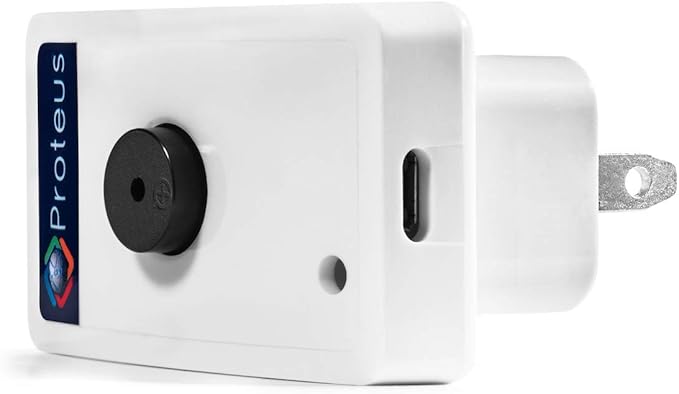
For homeowners seeking the most comprehensive water monitoring solution, the Proteus Aquo offers advanced features and customization options that justify its premium price. This AC-powered sensor provides reliable monitoring with extensive notification capabilities.
Key Features
- AC-powered design eliminates battery concerns
- Expandable with up to 5 different sensor types (puck, cable, sump)
- Advanced notification options including voice calls and WhatsApp
- 83dB built-in alarm
- Web-based management interface
- Integration with Amazon Alexa, Google Home, and IFTTT
- API access for advanced smart home integration
Pros
- No batteries to replace (AC powered)
- Highly customizable notification options
- Expandable with multiple sensor types
- Advanced smart home integration
- API access for custom applications
Cons
- Significantly higher price ($99.00)
- Requires AC power outlet
- More complex setup process
- No smartphone app (web interface only)
Technical Specifications
| 3.5″ x 3.5″ x 2″ | AC power (100-240V) |
| N/A (AC powered) | Wi-Fi (2.4GHz) |
| 83dB | Amazon Alexa, Google Home, IFTTT |
| Not specified | 2 years |
“The Proteus Aquo stands out for its extensive customization options. While the setup process is more involved than other sensors, the ability to add multiple sensor types and receive notifications through various channels makes it ideal for protecting high-value areas or homes with complex water systems.”
4. Govee Water Leak Detector 2 – Best Multi-Sensor System
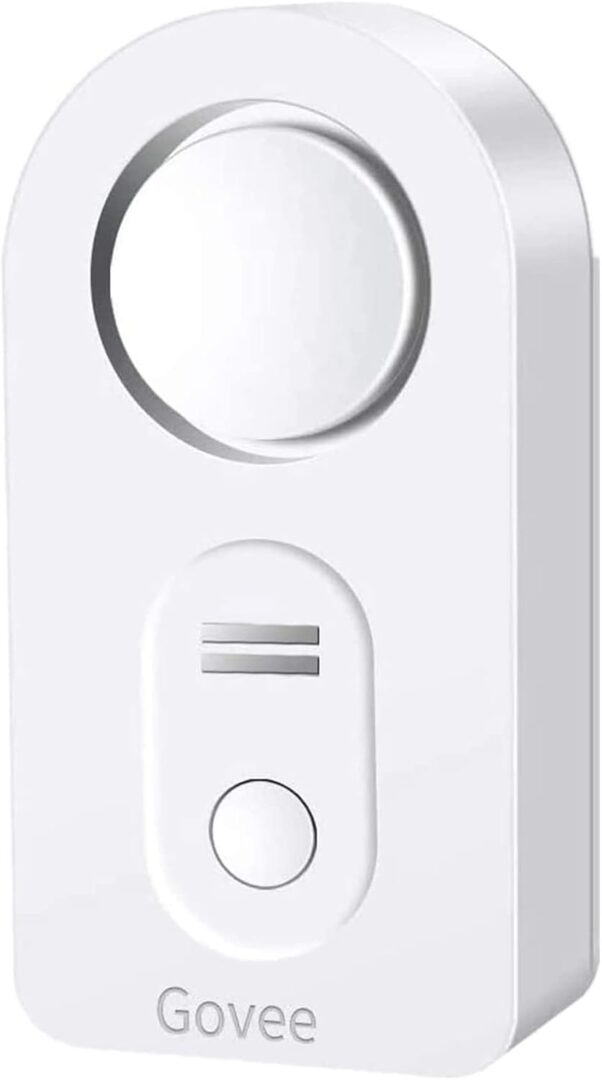
The Govee Water Leak Detector 2 is our top recommendation for homeowners looking to monitor multiple locations throughout their home. Available in convenient multi-sensor bundles, this system offers excellent coverage at a competitive price point.
Key Features
- Available in 4-sensor and 6-sensor bundles with hub
- Dual detection with top and bottom sensors
- LoRa wireless technology for extended range
- 100dB built-in alarm
- Temperature monitoring capabilities
- Amazon Alexa integration
- Clean, intuitive smartphone app
Pros
- Excellent value in multi-sensor bundles
- Both top and bottom water detection
- Long wireless range with LoRa technology
- Loud 100dB alarm
- Clean, user-friendly app interface
Cons
- Requires Govee hub purchase
- Limited smart home platform support
- Slightly larger size than some competitors
Technical Specifications
| 2.8″ diameter x 1.1″ height | 2 AAA batteries (included) |
| Up to 18 months | LoRa (requires Govee hub) |
| 100dB | Amazon Alexa |
| IP66 | 1 year |
“The Govee multi-sensor bundles provide excellent value for whole-home protection. During our testing, the sensors performed nearly identically to our top pick, with quick response times and reliable notifications. The clean app interface makes managing multiple sensors particularly easy.”
5. Moen Smart Leak Detector – Best for Tight Spaces
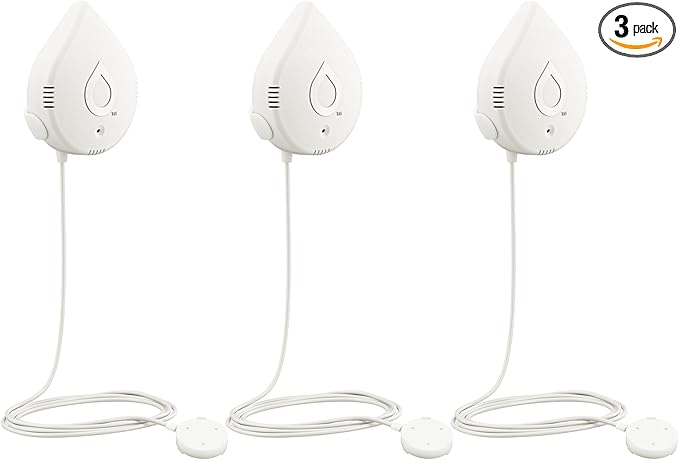
The Moen Smart Leak Detector features an innovative design with an ultra-thin sensing disc that can fit in spaces where other sensors can’t. This makes it ideal for monitoring under refrigerators, dishwashers, and other tight spaces.
Key Features
- Ultra-thin sensing disc (0.26″ thick) for tight spaces
- Extendable sensing cable (up to 18 feet with extensions)
- Direct Wi-Fi connectivity (no hub required)
- 85dB built-in alarm
- Temperature and humidity monitoring
- Water detection along entire cable length
- Compatible with Moen’s smart water shutoff systems
Pros
- Ultra-thin sensing disc fits under appliances
- No hub required (direct Wi-Fi connection)
- Extendable sensing cable for flexible placement
- Compatible with Moen’s water shutoff systems
- Entire cable detects water (not just at ends)
Cons
- Higher price point ($49.99)
- Limited smart home integration
- Moderate alarm volume (85dB)
- Extension cables sold separately
Technical Specifications
| Main unit: 3.5″ x 1.5″ x 1″ / Disc: 2″ diameter x 0.26″ height | 2 AA batteries (included) |
| Up to 12 months | Wi-Fi (2.4GHz) |
| 85dB | Moen ecosystem |
| Not specified | 1 year |
“The Moen detector’s ultra-thin sensing disc is a game-changer for monitoring under appliances. At just 0.26 inches thick, it easily slides into spaces where other sensors simply won’t fit. The ability to extend the sensing cable up to 18 feet provides excellent flexibility for monitoring larger areas.”
6. Aqara Water Leak Sensor – Best for Apple HomeKit
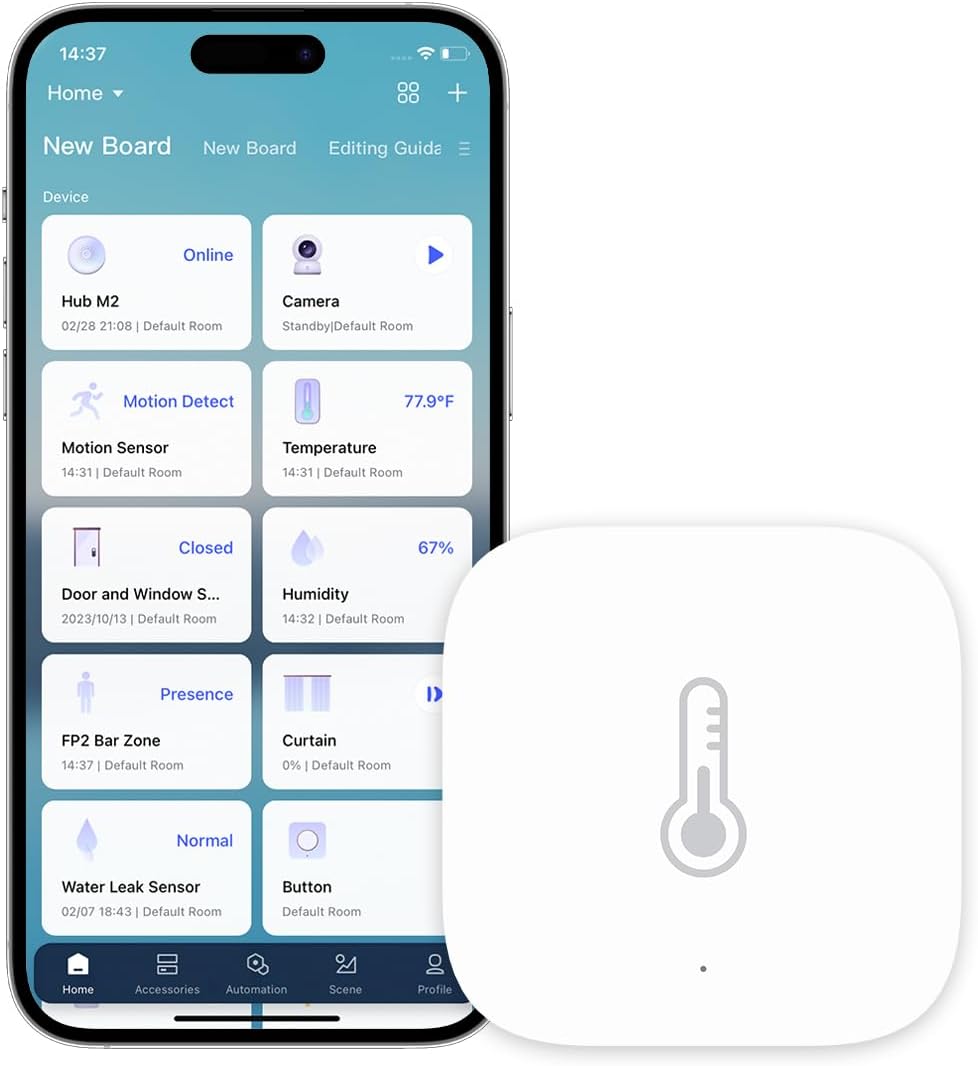
The Aqara Water Leak Sensor is the standout choice for Apple users, offering native HomeKit integration that’s rare in the water sensor market. This ultra-compact sensor works seamlessly with Apple’s Home app and Siri voice commands.
Key Features
- Native Apple HomeKit integration
- Ultra-compact design (0.59″ tall)
- Zigbee connectivity for reliable mesh networking
- 80dB built-in alarm
- Long battery life (up to 2 years)
- Works with Aqara Hub for additional smart home features
- Compatible with Amazon Alexa and Google Assistant (with Aqara Hub)
Pros
- Native Apple HomeKit support
- Ultra-compact, low-profile design
- Long battery life (up to 2 years)
- Reliable Zigbee connectivity
- Affordable price point ($19.99)
Cons
- Requires Aqara Hub or Apple HomePod/Apple TV
- Only bottom-mounted probes (no drip detection)
- Moderate alarm volume (80dB)
- Limited notification options without HomeKit
Technical Specifications
| 2.2″ diameter x 0.59″ height | CR2032 battery (included) |
| Up to 2 years | Zigbee (requires Aqara Hub or Apple HomePod/Apple TV) |
| 80dB | Apple HomeKit, Amazon Alexa, Google Assistant (with Aqara Hub) |
| IP67 | 1 year |
“For Apple HomeKit users, the Aqara sensor is the clear winner. The native integration allows for powerful automations through the Home app, such as flashing lights or playing announcements on HomePods when a leak is detected. The ultra-slim design is also perfect for discreet placement.”
7. Risinglink Smart Water Level Monitor – Best for Water Tanks
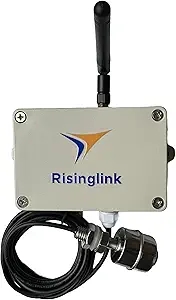
Unlike most water sensors that detect leaks, the Risinglink Smart Water Level Monitor is designed specifically for monitoring water levels in tanks, cisterns, and sumps. Its float sensor provides accurate readings of water levels with high and low-level alerts.
Key Features
- Stainless steel float sensor for durability
- 6.5-foot cable for flexible placement
- Direct Wi-Fi connectivity (no hub required)
- Multiple notification options (email and text)
- Support for multiple users (2 phone numbers, 4 email addresses)
- Waterproof design for outdoor use
- Battery-powered with 3 AAA batteries (included)
Pros
- Purpose-built for water level monitoring
- Durable stainless steel float sensor
- No hub required (direct Wi-Fi connection)
- Multiple notification options
- Waterproof for outdoor use
Cons
- Higher price point ($94.99)
- Limited smart home integration
- No built-in alarm
- Some users report Wi-Fi connectivity issues
Technical Specifications
| 4.72″ x 4.92″ x 1.57″ | 3 AAA batteries (included) |
| Up to 12 months | Wi-Fi (2.4GHz) |
| N/A (no built-in alarm) | None |
| IP65 | 1 year |
“The Risinglink monitor fills a specific niche for those needing to monitor water levels rather than detect leaks. It performed reliably in our tests with cisterns and sump pits, providing accurate notifications when water levels changed. The stainless steel float sensor proved durable even in harsh conditions.”
8. Shonmau Water Level Detector – Best Budget Option
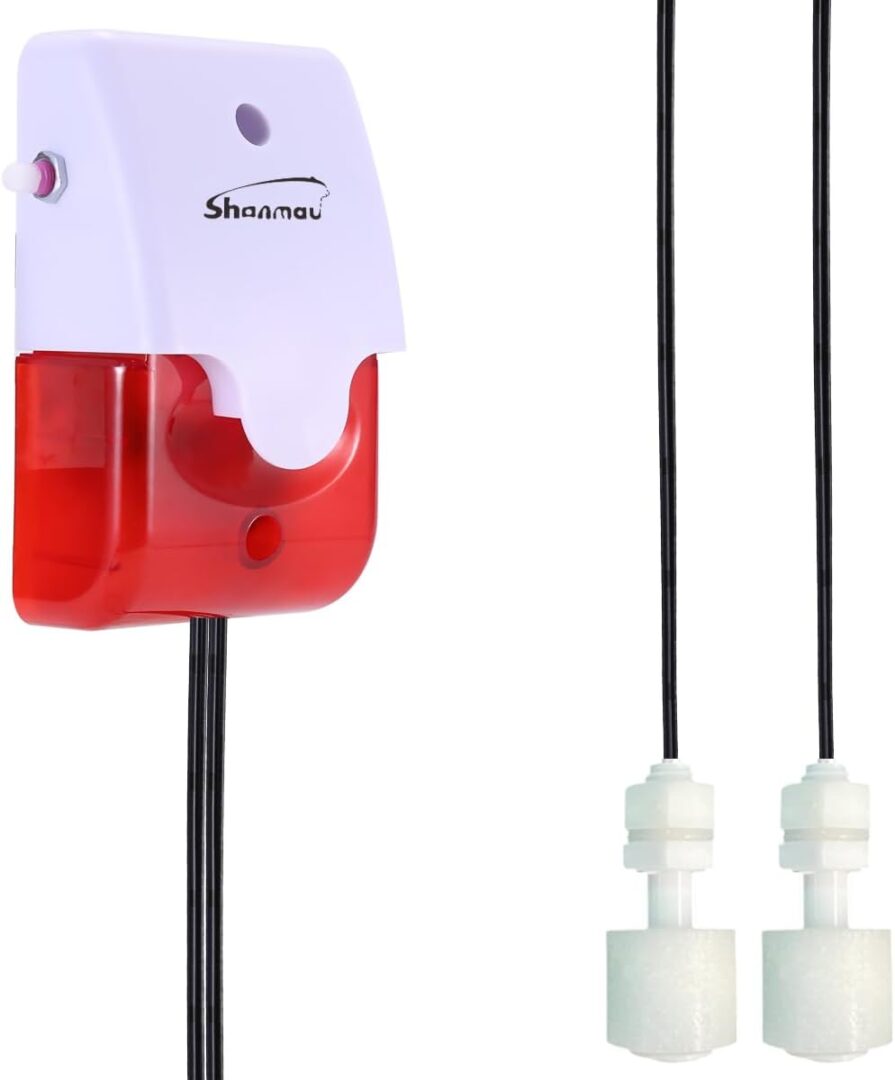
The Shonmau Water Level Detector offers a no-frills approach to water level monitoring at an extremely affordable price point. While it lacks smart features, its incredibly loud alarm and simple operation make it a reliable option for budget-conscious homeowners.
Key Features
- Extremely loud 120dB alarm with red strobe light
- Dual 5-meter floating probes for high/low water detection
- Adjustable alarm volume
- No Wi-Fi or hub required (standalone operation)
- Extendable probe cord (up to 16.4 feet)
- 9V battery power with 1+ year standby time
- Versatile for tanks, pools, basements, and more
Pros
- Extremely affordable price ($19.99)
- Incredibly loud 120dB alarm
- No Wi-Fi or hub required
- Adjustable alarm volume
- Simple setup with no app required
Cons
- No smart features or notifications
- No temperature monitoring
- Some users report quality control issues
- Awkward battery replacement process
Technical Specifications
| 4.84″ x 2.76″ x 1.77″ | 9V battery (included) |
| Up to 12 months (standby) | None (standalone) |
| 120dB (adjustable) | None |
| Not specified | 90 days |
“The Shonmau detector’s 120dB alarm is truly impressive – it’s among the loudest we’ve tested and ensures you’ll be alerted even from a distance. While it lacks smart features, its simplicity is actually an advantage for those who prefer a straightforward, reliable solution without the complexity of apps and Wi-Fi setup.”
9. EPTTECH Smart Liquid Level Indicator – Best for Multiple Liquids
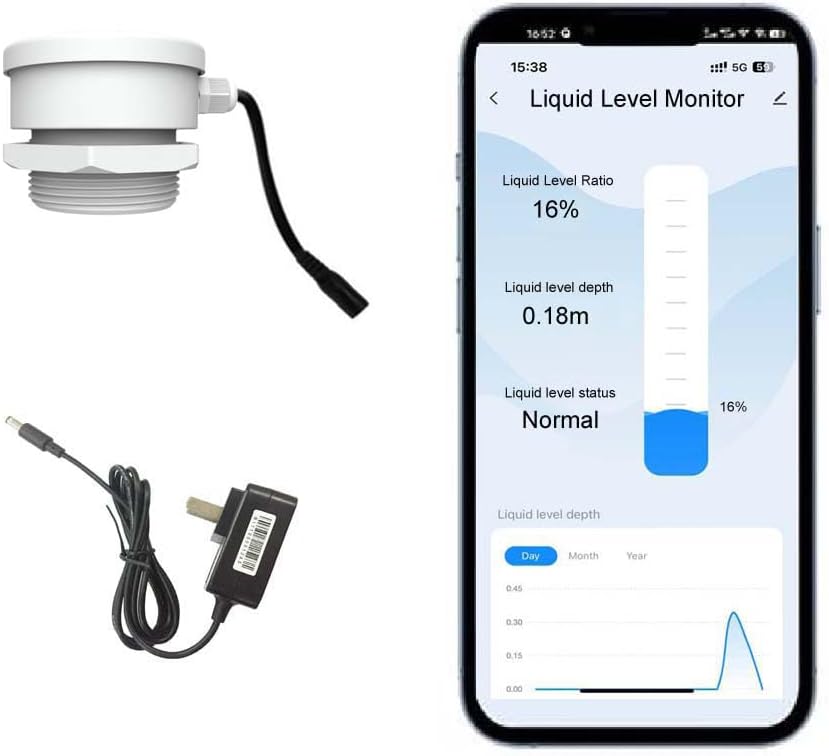
The EPTTECH Smart Liquid Level Indicator stands out for its versatility, capable of monitoring not just water but also fuel, oil, and other liquids. This makes it ideal for homeowners with multiple monitoring needs, such as water tanks, fuel storage, and more.
Key Features
- Multi-liquid monitoring capabilities
- Direct Wi-Fi connectivity (no hub required)
- AC powered for continuous operation
- Support for monitoring up to 10 sensors from one app
- Waterproof design
- Real-time level display without opening tanks
- Customizable alerts for empty or low levels
Pros
- Versatile for multiple liquid types
- No batteries to replace (AC powered)
- Support for multiple sensors in one app
- No hub required (direct Wi-Fi connection)
- Real-time level monitoring
Cons
- Higher price point ($56.00)
- Requires AC power outlet
- Some users report inconsistent readings
- Limited smart home integration
Technical Specifications
| 3.74″ x 3.74″ x 2.8″ | AC power (corded) |
| N/A (AC powered) | Wi-Fi (2.4GHz) |
| N/A (no built-in alarm) | TUYA platform |
| IP65 | 1 year |
“The EPTTECH indicator’s ability to monitor different types of liquids makes it uniquely versatile. During our testing, it accurately tracked levels in water tanks, oil containers, and even a small fuel tank. The ability to monitor up to 10 sensors from one app is particularly valuable for properties with multiple tanks.”
10. Tuehakny 2-in-1 Water Detector – Best Dual-Function Sensor

The Tuehakny 2-in-1 Water Detector offers unique versatility with its dual probe design, allowing it to simultaneously monitor for water leaks and water levels. This makes it an excellent choice for areas where both functions are needed.
Key Features
- Dual probe design for simultaneous leak and level detection
- Direct Wi-Fi connectivity (no hub required)
- 100dB adjustable alarm (High/Medium/Low/Mute)
- Different sounds and app alerts to distinguish between probes
- Battery-powered with 2 AAA batteries (included)
- Optional SMS/phone call alerts (paid service)
- Low battery indicator (flashes and beeps)
Pros
- Dual-function capability
- No hub required (direct Wi-Fi connection)
- Adjustable alarm volume
- Affordable price point ($24.99)
- Distinguishes between different alerts
Cons
- Some users report Wi-Fi connectivity issues
- SMS/phone call alerts require additional payment
- Some reports of quality control issues
- Limited smart home integration
Technical Specifications
| 1.26″ x 0.78″ x 3.5″ | 2 AAA batteries (included) |
| Up to 12 months | Wi-Fi (2.4GHz) |
| 100dB (adjustable) | Tuya platform |
| Not specified | 1 year |
“The Tuehakny’s dual-probe design is genuinely innovative, allowing it to monitor both for leaks and water levels simultaneously. During our testing, the different alert sounds made it easy to distinguish which probe was triggered, and the adjustable volume was particularly useful for different installation locations.”
Water Sensor Buying Guide: How to Choose the Right Water Sensor
Detection Method
Water sensors use different methods to detect water, each with advantages for specific situations:
- Contact Sensors: The most common type, using probes that detect water when it bridges the gap between them. Look for sensors with both top and bottom probes for maximum coverage.
- Float Sensors: Better for monitoring water levels in tanks, sumps, or cisterns. These detect rising or falling water levels rather than leaks.
- Cable Sensors: Extended sensing cables that can cover a larger area or wrap around pipes. Ideal for water heaters, washing machines, or along baseboards.
Connectivity Options
How your sensor communicates affects its range, reliability, and features:
- Wi-Fi: Direct connection to your home network without requiring a hub. Typically easier to set up but may have shorter battery life.
- LoRa: Long-range wireless technology that requires a hub but offers exceptional range (up to 1/4 mile) and better battery life.
- Zigbee: Mesh networking technology that requires a hub but offers reliable connectivity and good battery life.
- Standalone: No wireless connectivity, relying solely on audible alarms. Simple but lacks remote notification capabilities.
Alert Types
Consider how you want to be notified of potential water issues:
- Audible Alarms: Built-in sirens ranging from 80dB to 120dB. Louder alarms (95dB+) are recommended for larger homes.
- Smartphone Notifications: Push alerts through a dedicated app when water is detected.
- Email/SMS: Text messages or emails for when you’re away from home.
- Smart Home Alerts: Notifications through smart speakers, flashing lights, or other connected devices.
Power Source
Battery life and power options are important considerations:
- Battery-Powered: Most common, offering flexible placement but requiring periodic battery replacement (typically every 1-2 years).
- AC-Powered: No batteries to replace but requires proximity to an outlet and may not work during power outages.
- Battery Backup: Some AC-powered models include battery backup for continuous protection during outages.
Smart Home Integration
If you have a smart home system, look for compatible sensors:
- Amazon Alexa: Most common integration, allowing for voice notifications and automations.
- Google Home: Less common but growing in availability.
- Apple HomeKit: Limited options (Aqara is the standout choice).
- IFTTT: Allows for custom automations with other smart devices.
Frequently Asked Questions About Water Sensors
Where should I place water sensors in my home?
The most important locations for water sensors include:
- Near water heaters and washing machines
- Under sinks in kitchens and bathrooms
- Near dishwashers and refrigerators with water lines
- In basements, especially near sump pumps
- Under air conditioning units with condensate lines
- Near toilets that have overflowed in the past
For comprehensive protection, consider placing sensors in all these locations, prioritizing areas with previous issues or expensive equipment.
How do water sensors work?
Most water sensors use conductive probes that detect when water creates an electrical connection between them. When water bridges this gap, it completes a circuit that triggers the alarm and notifications. Some advanced sensors also measure temperature to detect freezing conditions that could lead to burst pipes.
Float sensors work differently, using a magnetic mechanism that activates when water levels rise or fall beyond certain thresholds, making them better suited for monitoring tanks and sumps.
Do I need a hub for water sensors?
It depends on the sensor type. Wi-Fi sensors connect directly to your home network without requiring a hub. However, sensors using LoRa (like YoLink) or Zigbee (like Aqara) protocols require a compatible hub to connect to your network.
Hub-based systems typically offer better range and battery life but increase the initial cost. They also often support multiple sensors, making them more cost-effective if you plan to install several sensors throughout your home.
How long do water sensor batteries last?
Battery life varies significantly between models:
- Wi-Fi sensors typically last 6-18 months
- LoRa and Zigbee sensors often last 1-2 years
- Standalone sensors without wireless connectivity may last 1+ years
Factors affecting battery life include connection type, notification frequency, and environmental conditions. Most smart sensors will send low battery notifications through their apps before batteries need replacement.
Can water sensors automatically shut off water?
Most standalone water sensors cannot shut off water supply by themselves. However, some can integrate with smart water shutoff valves to provide this functionality. For example, the Moen Smart Leak Detector can work with Moen’s Flo Smart Water Shutoff system.
For comprehensive protection, consider pairing water sensors with a smart water shutoff valve installed on your main water line. These systems can automatically cut water supply when leaks are detected, preventing extensive damage.
Conclusion: Protecting Your Home from Water Damage
Water damage can be devastating to your home and belongings, but today’s smart water sensors provide an affordable and effective way to detect leaks early. Our comprehensive testing shows that the YoLink Water Leak Sensor 4 offers the best combination of features, reliability, and value for most homeowners, while alternatives like the Kidde Water Leak + Freeze Detector provide excellent hub-free options.
When selecting a water sensor, consider your specific needs, including the areas you need to monitor, your preferred notification methods, and compatibility with existing smart home systems. For comprehensive protection, we recommend placing multiple sensors throughout your home, focusing on high-risk areas like water heaters, washing machines, and under sinks.
By investing in quality water sensors now, you can potentially save thousands in repair costs and avoid the stress and disruption that water damage brings. The peace of mind that comes from knowing you’ll be alerted at the first sign of a leak is well worth the modest investment in these innovative devices.
Comprehensive water sensor placement provides whole-home protection against water damage
As an Amazon Associate, I earn from qualifying purchases. This means that if you click on an Amazon link and make a purchase, I may earn a small commission at no extra cost to you. Thank you for your support!


